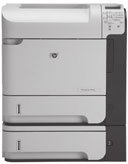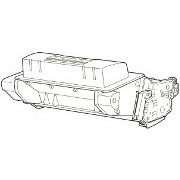HP Original Cartridges
Reliable Remanufactured Cartridges
One of the merits of the P4014 against a new printer is the low cost of good re-manufactured cartridges.
At the moment we don't sell in the US, but we hope to soon
CC364A and CC364X remanufactured cartridges for Laserjet P4014 and P4015 Series Printers.


The LaserJet P4014, P4015 and P4515 are fast, reliable laser printers with an A4 paper path and a selection of paper handling options. The P4515 throughput is up to 62 pages per minute and the processor, memory and network abilities are sufficient to sustain it.
These printers have one of the lower toner costs in the industry - about 0.7p per page if you buy the big cartridges. IT buyers in banking, insurance and legal offices will be satisfied with that.
Some big copier-like machines might lower the cost further - to 0.3p or below. These very low costs usually mean separating toner from developer and drum, or even having three different components and toner supplied in a bottle.
Weasel-word in the last paragraph was "might"! The cost of actual printing might be lower, but support costs MIGHT rise. Some technical knowledge is needed to say whether a fault might be toner hopper, developer, drum or sensor - or something else entirely. The HP approach of providing all in one cartridges means most faults can be cleared and work continue by ordinary users with no special knowledge just changing the cartridge. (A print cartridge changes the drum, developer, precharge roller, waste scraper and recovery blades - often estimated to be three-quarters of the failure prone parts in the printer. Others that might affect the page image are the transfer roller and fuser. Pickup and feed rollers do wear out but cause misfeeds not bad print.
The all-in-one print cartridge has that merit of simplicity. Problems, interruptions, disruption and complete halts for a breakdown are a significant cost in printing. If you need a new cartridge or maintenance kit it will probably be there next-day (same day is expensive). Break a drive shaft - wait. Don't understand what has gone wrong - pay for an engineer call-out.
Recycle General term for any kind of re-use off the cartridge including recovering the materials for shredding and re-use. Re-use of metals is commonplace everywhere but re-use of plastics might involve separating melting and pelletising it so that it can be reused or burning it for energy. Either might be valid.
Refill Simply remove the filling bung and put more toner in. Maybe drill a hole in waste chamber and take the waste out. Since the 64A cartridge lasts 10,000 pages and the 64X lasts 24,000 and they use the same components at least one refill of a 64A looks possible. Modern toners are quite complex and need to be a good match to the print system. Refill was once popular but reliability issues undermined that.
Remanufactured cartridges are dismantled to a greater or lesser extent. This allows the components to be inspected and triaged. Many plastic shells will be acceptable, but interest might focus on the recovery blade. Some drums might work, a more sophisticated operation might test them with an optical and / or electronic. Ideally we might hope they will thoroughly clean all the components, use new drum, wiper and doctor blade, resurface the developer and then fill the result with an entirely compatible toner. Doing all of that might cost more than making a manufacturers original cartridge of course. It also produces a considerable waste-stream to be sent elsewhere.
Compatible cartridges may not be recycled at all; just clone parts. They could be as good as manufacturer originals, in principle they might even be better since there are often huge margins on cartridges (better hardly ever happens). In practice compatible 64A / 64X cartridges run the risk of being "illegal" by breaching one or more of HP and Canon's patents or copyrights. What drives cartridge recycling is not primarily a green ethos, it's that if you put half a kilo of black toner worth something like £5-10 into parts recovered from the waste stream you have a product roughly equivalent to an HP product that costs almost £100. If you make the components for refill or clone cartridges then there is a risk of breaching patents - and a complete copy cartridge will most certainly bring attention from HP's lawyers (and they can afford good advice).
One way to get the up-front cost of the cartridge down is to use recycled, refill, "re-manufactured" or compatible products. It is possible to halve running costs this way.
Again, there is that potential rise in support costs. When the printer misbehaves, could it be a bad cartridge?
First the negatives. It's worth noting that refill toners might :
- Leak making a mess in the printer that proves difficult to clear.
- Use inappropriate grades of toner that will not make the best of the printer's resolution and grey-scale.
- Use grades of toner that don't properly match the qualities of the fuser surface causing backgrounding in print and shortening the fuser life.
- Create problems that results in field service calls - there is a suggestion that cartridges overfilled with inferior grade toner can overload the drum drive motor splitting its cog. the cost of fixing this sort of fault could greatly exceed savings on toner.
HP don't attempt to ban the use of non-HP cartridges. However:
- Printers may report that a cartridge is not HP when it is installed (Error 10). This is based on the "killer chip" response.
- The toner consumption and page-count facilities may not work unless it has a "clone" chip such as those supplied by Static Control.
- HP do allow use of refill toners under warranty. However they note that damage caused by a non-HP cartridge is not covered under their warranty and service agreements, so it may be wise to check that a fault persists when an original toner is used before making a warranty call.
On the other hand if you have technical support staff who know about printers, screwdriver skills and a toner-rated vacuum cleaner you could certainly operate these printers at well under the cost implied by HP cartridges and if on the odd occasion something does go rather awry it won't be too inconvenient.
We don't entirely endorse manufacturers campaigns in favour of their original toners, they have a big vested interest. Experience suggests that HP original cartridges generally are reliable. Refilled and compatible cartridges have sometimes proved less reliable and we have experience of them creating field service calls and of printers needing to be removed from site for cleaning.
Copyright G & J Huskinson & MindMachine Associates Ltd 2013, 2015. Some pictures derived from HP User and Service guides. These technical pages do not constitute an offer for sale; just our knowledge at the time of writing. See the catalogue. Sales pages on this Web site use cookies to store user information. We also use Google Analytics to track site usage patterns.

